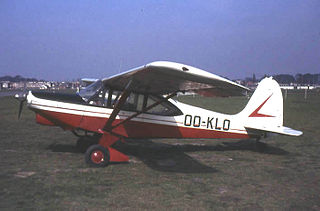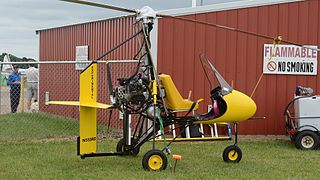Related Research Articles

The Distributor Wing DW-1 was a prototype agricultural aircraft of unorthodox design, designed by Ken Razak in the United States and marketed by Aerial Distributors in the 1960s.

The Beechcraft Musketeer is a family of single-engined, low-wing, light aircraft that was produced by Beechcraft. The line includes the Model 19 Musketeer Sport, the Model 23 Musketeer, Custom and Sundowner, the Model 23-24 Musketeer Super III, the retractable gear Model 24R Sierra and the military CT-134 Musketeer.

The Stinson 108 is a popular single-engine, four-seat, light general aviation aircraft produced by the Stinson division of the American airplane company Consolidated Vultee, from immediately after World War II to 1950. The 108 was developed from the prewar Model 10A Voyager.

The SZD-45 Ogar (Hound) is a T-tailed cantilever high-wing monoplane of wooden, aluminium and fibreglass construction designed and manufactured in Poland.

The Cessna Airmaster, is a family of single-engined aircraft manufactured by the Cessna Aircraft Company. The Airmaster played an important role in the revitalization of Cessna in the 1930s after the crash of the aviation industry during the Great Depression.

The Bellanca 14-13 Cruisair Senior and its successors are a family of light aircraft that were manufactured in the United States by AviaBellanca Aircraft after World War II. They were a follow-up to the prewar Bellanca 14-7 and its derivatives.

The Boisavia B.60 Mercurey was a series of four-seat light aircraft developed in France shortly after World War II.

The Colonial Model C-1 Skimmer was an American small single-engined amphibian flying boat built by the Colonial Aircraft Corporation. It was the start of a line of very similar aircraft designed by David Thurston.

The Goodyear GA-2 Duck is a 1940s American three-seat light amphibious aircraft built by the Goodyear Aircraft Corporation. The design team included David Thurston, who later developed several other light seaplanes including the Colonial Skimmer, Lake Buccaneer, Thurston Teal and Seafire. Only 19 aircraft were built, and these were used only for testing and as demonstrators.

The Curtiss Model 55 Kingbird was an airliner built in small numbers in the United States in the early 1930s. It was a twin-engine aircraft with a fuselage derived from the single-engine Curtiss Thrush. The Kingbird had two engine nacelles mounted on the struts on either side of the fuselage that braced the wing and the outrigger undercarriage. A distinctive design feature was the aircraft's blunt nose, located behind the propeller arcs. This allowed the engines to be mounted closer to each other and to the aircraft's centerline, therefore minimising asymmetrical thrust in case of an engine failure. For the same reason, the Thrush's single tailfin was replaced by twin tails on the Kingbird, and the main production model, the D-2 fitted a second horizontal stabilizer and elevator between these fins.
The Piper PA-6 Sky Sedan was a 1940s American four-seat light aircraft designed and built in prototype form by Piper Aircraft at its Lock Haven, Pennsylvania, factory.

The Freedom Aviation Phoenix was a single-engine four-seat American airplane that was sold as a homebuilt composite canard aircraft.

The Gadfly HDW.1 is a 1960s British two-seat cabin autogyro.

The Gwinn Aircar was a single-engined biplane with a cabin for two, designed in the US as a safe and simple private aircraft. Lacking a rudder, it had several unusual control features as well as an early tricycle undercarriage. Development was abandoned after a crash in 1938.

The Douglas Cloudster II was an American prototype five-seat light aircraft of the late 1940s. It was of unusual layout, with two buried piston engines driving a single pusher propeller. Only a single example was built, which flew only twice, as it proved too expensive to be commercially viable.
The Aristocraft II was a six-place homebuilt aircraft designed by Terrence O'Neill.

The Rotor Flight Dynamics Dominator is an American autogyro designed by Ernie Boyette of Rotor Flight Dynamics of Wimauma, Florida, and made available in the form of plans and kits for amateur construction.

The GT-Gyroplanes Kruza (Cruiser) is an Australian autogyro, designed by brothers Geoff and Alistair Morrison and produced by GT-Gyroplanes of Moama, New South Wales. The aircraft is supplied as a kit for amateur construction or as a complete ready-to-fly-aircraft.
The Viper Aircraft Viperfan was an American homebuilt aircraft that was designed and produced by Viper Aircraft of Kennewick, Washington, introduced in the late 1990s. It was intended to be supplied as a kit for amateur construction, but only one was ever built.

The Farman HF.6 was a reconnaissance aircraft built in France shortly before the First World War.